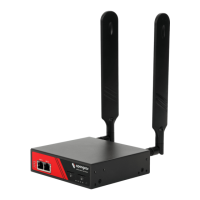User Manual
6. Enter a Left ID and Right ID. This is the identifier that the Local host/gateway and remote
host/gateway use for IPsec negotiation and authentication. Each ID must include an @ and can
include a fully qualified domain name ( e.g. left@example.com)
7. Enter the public IP or DNS address of this Opengear VPN gateway as the Left Address. You can
leave this blank to use the interface of the default route
8. In Right Address enter the public IP or DNS address of the remote end of the tunnel (only if the
remote end has a static or dyndns address). Otherwise leave this blank
9. If the Opengear VPN gateway is serving as a VPN gateway to a local subnet (e.g. the console
server has a Management LAN configured) enter the private subnet details in Left Subnet. Use the
CIDR notation (where the IP address number is followed by a slash and the number of ‘one’ bits in
the binary notation of the netmask). For example, 192.168.0.0/24 indicates an IP address where
the first 24 bits are used as the network address. This is the same as 255.255.255.0. If the VPN
access is only to the console server and to its attached serial console devices, leave Left Subnet
blank
10. If there is a VPN gateway at the remote end, enter the private subnet details in Right Subnet. Use
the CIDR notation and leave blank if there is only a remote host
11. Select Initiate Tunnel if the tunnel connection is to be initiated from the Left console server end.
This can only be initiated from the VPN gateway (Left) if the remote end is configured with a static
(or dyndns) IP address
12. Click Apply to save changes
NOTE Configuration details set up on the console server (referred to as the Left or Local host) must
match the set up entered when configuring the Remote (Right) host/gateway or software client.
See http://www.opengear.com/faq.html for details on configuring these remote ends
3.10 OpenVPN
The ACM7000, CM7100, and IM7200 with firmware V3.2 and later include OpenVPN. OpenVPN uses the
OpenSSL library for encryption, authentication, and certification, which means it uses SSL/TSL (Secure
Socket Layer/Transport Layer Security) for key exchange and can encrypt both data and control channels.
Using OpenVPN allows for the building of cross-platform, point-to-point VPNs using either X.509 PKI
(Public Key Infrastructure) or custom configuration files.
OpenVPN allows secure tunneling of data through a single TCP/UDP port over an unsecured network, thus
providing secure access to multiple sites and secure remote administration to a console server over the
Internet.
OpenVPN also allows the use of Dynamic IP addresses by both the server and client thus providing client
mobility. For example, an OpenVPN tunnel may be established between a roaming windows client and an
Opengear console server within a data center.
Configuration of OpenVPN can be complex so Opengear provides a GUI interface for basic set up as
described below. More detailed information is available at http://www.openvpn.net
3.10.1 Enable the OpenVPN
1. Select OpenVPN on the Serial & Networks menu

